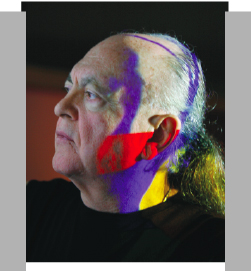
Adi Da Samraj (1939–2008) created art for over forty years with a single intention: the visual communication of truth, and the means to draw the viewer beyond separateness into the paradox of ‘indivisible unity.’ In addition to his artistic work, Adi Da Samraj is a widely recognized spiritual teacher who produced many volumes of spiritual writings.
Adi Da graduated from Columbia University in 1961 with a BA in philosophy, and from Stanford University in 1966 with an MA in English literature. His master’s thesis was a study of the core issues in modernism focusing on Gertrude Stein and the painters of the same period.
In 2006 the artist moved to digital technology, while still combining hand-drawn and painted forms as well as photographs within his compositions. In November 2007, Adi Da Samraj reached what he described as the final resolution of his entire artistic process. This turning point enabled him to create non-representational art by using a unique method he named Orphic Font, or abstractions constructed from collages of pictographs. Adi Da felt this work to be the culmination of his artistic work and philosophy, the fully realized expression of transcendental realism.
Full-scale fabrications of Adi Da Samraj’s images have included many forms of media, from monumentally-scaled paints on aluminum, to large-scale pigmented inks on canvas, photographic and videographic works, sculptural light boxes, plasma screen installations, and projected performance events.
Adi Da Samraj was featured as an official solo collateral artist at the 2007 Venice Biennale. He then became the first contemporary artist to ever be given a solo exhibition by the city of Florence. His work has also been exhibited in galleries and museums in the United States. In response to the art of Adi Da, art critic Donald Kuspit has written, ‘It is a rare artist that can convey, convincingly, being face to face with the source of Being.’
Peter Weibel, Chairman of ZKM Center for Art and Media (Karlsruhe), further notes that ‘Adi Da’s pursuit of the spiritual paths found in early abstraction, from Kandinsky to Mondrian, and his translation of that pursuit into the digital age, restore a transcendental spirituality to the materialism of the machine aesthetic.’
And curator and historian Achille Bonito Oliva has said, ‘Adi Da’s image-work constitutes an epiphany in the sense that it presents itself neither in objective nor in subjective terms. It doesn’t belong either to the universe of the artistic search of the 20th century, the whole canon of optical-perceptual experimentation that was developed in the 1950s and 60s, nor on the other hand to an expressionist creation that tends to represent identity and subjectivity.’
